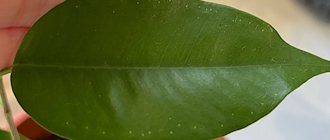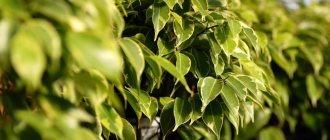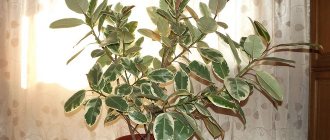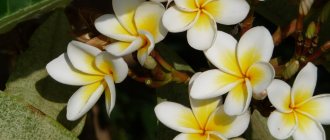floravdome.ru > Decorative foliage > Rubber-bearing ficus (ficus elastica) at home
Ficus in nature
The homeland of perhaps the most popular type of ficus is India and the islands of the Indian Ocean.
Its unpretentiousness and bright appearance quickly made it one of the most common plants in homes and institutions.
At home, the plant grows to an impressive size - two to three tens of meters; at home, with good maintenance, it quickly grows to 3-4 meters.
The Latin name - Ficus elastica - was given to the plant, since its milky sap is the raw material of natural rubber.
! Ficus is not poisonous, but the milky sap can cause irritation to the skin and mucous membranes.
Ficus rubbery Description
Ficus rubber is distinguished by large glossy oval leaves, pointed at the top. Young leaves are wrapped in stipules, which quickly dry out after the leaves open.
Depending on the variety, the color of the leaves can be of different shades - from light to dark, almost black. There are also variegated, 3-4-color (variegated) colors, for example the Tineke and Belize .
At home, ficus blooms very rarely, but it is valued, first of all, for the beauty of its leaves.
Ficus Belize
The location in the room needs to be given special attention.
Ficuses do not like moving from place to place and grow quite quickly (in six months they can grow up to half a meter), so it is better to choose a place for a large ficus “with a reserve” .
It is important that the plant does not stand in a draft and is not exposed to sudden temperature changes.
Lighting and temperature
Ficus Belize, which is cared for in the same way as most variegated plants, needs good lighting, which determines the variegation of color. During the greatest solar activity, the flower should be shaded so that direct rays of the sun do not leave burns on it. Windows facing the south, southwest or southeast are better suited for Elastica. In summer, it is recommended to take the flower out into the fresh air.
Ficus Belize is a heat-loving plant, so the temperature in the place allocated for it should be +20-25 degrees in the summer season and +15 in the winter. Sudden temperature changes and drafts should be avoided.
Humidity
Ficus elastica tolerates normal room humidity well, but, like most tropical plants, it loves high humidity.
It’s easy to provide – just daily spraying .
You can simply place a humidifier or a container of water nearby. This will improve the appearance of the plant and have a positive effect on its growth.
In the summer, ficus responds well to a warm shower . It is better to carry out the bath procedure in the evening and leave the plant in the bath overnight until the leaves are completely dry. Or wipe wet leaves dry with a soft cloth.
If you expose a wet plant to the sun's rays, sunburn in the form of brown spots may appear on the leaves, which will affect the health of the flower and its decorative appearance.
Also, from time to time, the leaves are wiped with a damp sponge to remove dust. In addition to cleansing, this hygienic procedure has a positive effect on plant growth.
Characteristics of ficus Belize
Ficus elastica Belize belongs to the Mulberry family. Wide oval leaves grow up to 22-23 cm long and up to 13 cm wide. The leaf is compacted, leathery, with a glossy surface, pointed at the top. The vein running through the center is well defined and burgundy in color. But the most interesting thing is the color of the foliage. In the middle the leaf is rich green, with white and pink tones along the edges.
Pros of ficus Belize
The advantages include the fact that Belize is one of the popular plants for home cultivation, as well as:
- high resistance to diseases and insect pests;
- ease of care;
- motley, special, bright appearance.
Watering
Ficus elastica, unlike other species, is moisture-loving and does not like drought, which leads to leaf fall .
At the same time, excessive watering can lead to root rot, disease and plant death .
It is easy to determine when watering is required - when the top layer of soil dries a couple of centimeters (you can check by plunging your finger into the soil).
Water abundantly, the soil should be moisture-permeable and easily allow water to pass through.
The water accumulated in the pan is drained.
Water for irrigation should be soft, settled, at room temperature or a little warmer.
Caring for ficus elastica
Ficuses in winter - care features
- The plant should not stand in a draft.
- It is important not to limit the plant’s light and maintain sufficient air humidity, but at low temperatures, it is better to refrain from spraying and place a container of water next to the plant.
- During the winter heating period, the ficus should be protected from heating devices.
- Reduce watering, but do not allow the soil to dry out completely. Drying is permissible to a depth of about half the pot (versus 2-3 cm from the surface in summer).
Botanical characteristics
The foliage is large in size (length - 23 cm, width - 13 cm), oval in shape, pointed ends, leathery, glossy structure. The main color is green with a reddish tint, the edges are white. The venation is pinnate, the central vein is purple-pink, clearly visible on both sides of the leaf blade. Petioles up to 2.5 cm long, raspberry color.
The stem is elongated, the size of the internodes is up to 3 cm, the woody layer is smooth, as the flower culture develops, it becomes coarser, and brown scars appear.
Feeding and fertilizing ficus
During the period of active growth (spring and summer), the plant is regularly fed with complex mineral fertilizer once every two weeks.
It is important to remember that ficus plants with green leaves are fed with nitrogen fertilizers to increase leaf mass.
For variegated varieties, are chosen to preserve the decorative appearance of the leaves . If there is an excess of nitrogen in the soil, then the variegated ficus will turn green.
Ficus also responds well to organic fertilizers , which can be alternated with mineral ones.
Ficus rubbery in the interior
Growing rules
For variegated ficus, it is necessary to create a microclimate close to the tropical. It loves high temperatures, but can tolerate short stays in the cold.
Optimal indicators:
- in summer - about 25°C;
- in winter - not lower than 15°C.
Drafts, cold floors and windowsills are contraindicated for indoor plants.
In winter, to avoid freezing of the root system, it is necessary to use pallets and wrap the potting container with a warm cloth.
Humidity
Suitable humidity conditions are 50% and above.
In winter, place a container of water next to the flower pot or use professional air humidifiers. In summer, in addition to watering, spray the leaf mass and take a warm shower.
Illumination
For the variegated subspecies of Elastica, good lighting is important. The duration of daylight hours is 12 hours or more. In winter, the lack of sun is compensated for by supplementary lighting with artificial sources - fluorescent lamps.
The more light there is in the room, the more contrasting and variegated the foliage will become.
The best place for a flower pot is the south, southeast or southwest side. However, even a tropical plant that prefers warmth needs to be protected from direct sunlight during the hot season.
Replanting ficus rubber
Ficus grows quickly, and young plants are replanted annually, choosing a pot a few centimeters larger than the previous one in depth and diameter.
When choosing a pot, it is important to consider that ficus plants grow well in slightly cramped conditions, and the pot should be selected according to the size of the root system . A pot that is too large will slow leaf growth until the roots fill the pot space. Therefore, a new pot for rubber ficus is taken 2-3 cm larger than the previous one in depth and diameter.
Adult ficus trees are not replanted, but the top layer of soil in the pot is renewed every year.
The soil for ficus is chosen to be air- and water-permeable. You can take ready-made soil or prepare the mixture yourself.
To prepare the soil yourself, take equal proportions of turf and leaf soil, peat and coarse river sand for loosening.
A drainage layer of several centimeters is required.
Home care
Belize Elastic is an artificially bred variety. The flower requires increased attention to maintenance conditions compared to monochromatic rubber plants. Ficus does not tolerate drafts and strong temperature changes. Unfavorable conditions can lead to disease, putrefactive formations, and shedding of leaves.
Watering
Belize is watered with filtered or settled water. Excess of chlorine affects the appearance of white stains on the leaves and inhibition of growth. Before the procedure, you need to make sure that the top layer of soil is dry. It is more advisable to water from below, placing the pot with the plant in a pan of water. The required amount of moisture will enter the soil through the drainage holes.
It is recommended to water the ficus in the summer - 2-3 times a week, in the winter - once every 10-15 days. Before watering, you need to make sure that the top layer of soil has dried to a depth of 2-3 cm. Otherwise, the procedure is postponed.
Reference! Belize tolerates drought more easily than overwatering. Waterlogged soil can cause the plant to shed its leaves.
Top dressing
Ficus needs to be fed from spring to autumn. Universal complex fertilizers are best suited, although some gardeners use exclusively natural organic matter.
In April, it is better to use fertilizers rich in nitrogen, which is required for active flower growth. It is better to end the feeding period in October with phosphorus-potassium complexes, which slow down growth and prepare the ficus for winter.
For feeding the following are used:
- vermicompost (a waste product of earthworms) is an excellent growth stimulator, improves immunity, and accelerates adaptation during transplantation;
- dolomite flour is a source of calcium and magnesium, reduces soil acidity;
- wood ash - rich in potassium, phosphorus, and microelements.
Bird droppings, leaf humus, succinic acid, and nettle infusion are also used. The frequency of feeding in summer is 3-4 times a month. In winter, in a warm room, ficus is fed 1-2 times a month; in a cold room, it is stopped.
Reference! It is recommended to alternate mineral fertilizing with organic fertilizing.
Lighting
- The variegated variety Belize needs bright light.
- Only under such conditions is the color range of the leaves preserved.
- Window sills on the south side of the room are best suited.
- Direct rays of the midday sun can cause the plant to burn, so it is better to shade it during this period.
Reference! With insufficient lighting, the variegation of leaves disappears, the red tint fades, and green color dominates.
Temperature and humidity
Comfortable temperature for Belize Elastic is 18-25 degrees. During the resting phase, it can be reduced to 15 degrees. In winter, you need to prevent the roots from overcooling on the windowsill or floor. In summer and during cold periods with the heating on, when the temperature rises above 25 degrees, regular spraying of the plant is required. To do this, use filtered or settled water at room temperature.
To increase the humidity of the surrounding air, it is recommended to place a container of water next to the flower. In winter, at temperatures below 18 degrees, it is enough to periodically wipe the leaves with a damp sponge.
When is pruning required?
The Belize Elastic variety is characterized by a pronounced vertical growth feature. Branching and development of lateral buds are stimulated by pinching the apex and pruning the shoots:
- The flower crown begins to form after 1 year.
- The elongated young shoots are trimmed with a sharp knife, and the cut areas are washed to remove any released juice.
- It is recommended to trim 5-6 internodes. It is enough to pinch the tip of the tender and soft shoot of the apex with your fingers.
- To form a lush crown, you can bend the top down and fix it in this position.
- The upper growth buds will wake up and begin active growth.
- After a while, the retainer is removed and the flower is returned to its original position.
Reference! Pruning and pinching are carried out in early spring.
Diseases and pests
Belize Elastic is resistant to infections and pests. Problems arise when the conditions of its detention are not met.
With excessive watering, fungal diseases can occur:
- sooty fungus;
- pythium;
- botrytis;
- Rhizoctonia.
Symptoms of the disease include yellowing and dropping of leaves, and the appearance of black and white putrefactive spots on the leaf blades. If a disease is detected, damaged and dead areas are removed, the plant is treated with fungicides:
- A weakened plant can be infested with aphids, spider mites and spider mites.
- Insects are removed mechanically, and the plant is treated twice with insecticides.
- In case of minor pest damage, it is permissible to treat the flower with a solution of tobacco and laundry soap for medicinal purposes.
Important! If there are doubts about the absence of diseases in the purchased ficus, it is better to quarantine it, placing it away from other flowers for 2-3 days.
Ficus elastica after purchase – Transplantation and care
After purchasing, you should carefully inspect the plant. No matter how well the plant is cared for in the store, there is always a risk of pests. Even if during inspection you do not find insects, the new plant is placed away from the existing house flowers for a week or two.
Conditions for quarantine should be gentle - do not place the plant under bright light, try to place the pot so that it is warm, and the flower does not get air from the window when ventilating.
After a week , when the flower adapts to new conditions, the plant must be replanted . Store-bought shipping soil is not suitable for long-term cultivation; the plant will quickly wither in it.
The transplant is done as usual, the only difference is that it is advisable to clean the roots as much as possible from store-bought soil.
In the first month after transplantation, the plant does not need feeding.
Transplanting rubber ficus
The formation of a beautiful bush should begin while the plant is young.
The location of the flower relative to the light is important.
To ensure that the plant grows evenly, the ficus is turned to the light in different directions . If this is not done, this will lead not only to uneven density of foliage, but also the trunk of the ficus may become bent.
How to prune rubber ficus
Most often, pruning is necessary to curb the growth of ficus. For pruning, use a sharp, disinfected knife.
The place for pruning is chosen above the future apical bud (in the internode) so that the new grown leaf covers the trimmed area and the trimmed stump does not catch the eye.
The milky juice released at the cut site is removed with running water, and after drying, sprinkled with ash or cinnamon.
Pruning the apical shoot of ficus elastica does not lead to branching , but can awaken the lateral buds . To do this, pruning is done in the spring, with the beginning of active growth. After pruning, the ficus can continue to grow in height.
The cut off top can be easily rooted.
When pruning for the purpose of shaping, one should take into account such an important factor as the size of the root system relative to the pot . If the plant has just been transplanted, and the roots have not had time to grow to the entire volume of the pot, then the growth of the above-ground part will have to wait - the plant will actively grow the root mass, and only then will it be time for leaves and side shoots.
On the other hand, if the roots have already completely entwined the earthen ball, and they have become cramped in the pot, there is a lack of nutrients and the plant has naturally slowed down in growth, then it is first necessary to transplant it into a larger pot. The transplant is done in early spring, and in this case pruning can be done in the fall, before the dormant period and wait for active growth in the new spring.
Even if the ficus elastica plant is grown as a tree and not a bush, pruning is still carried out periodically - old shoots, weak and damaged shoots, as well as elongated branches are removed.
! For old plants, experienced gardeners practice the method of awakening side shoots by piercing the trunk to 1/3 of the thickness . This stimulates dormant kidneys. This procedure is also effective in spring.
Ficus rubber pruning
There are several ways to propagate rubber ficus at home .
The simplest and most effective way is with cuttings. This method is suitable even for inexperienced gardeners.
Reproduction by layering requires experience, but this method is just as effective.
How to choose and how much it costs
It is better to buy ficus in the spring. During the spring-summer season, the indoor plant will go through an adaptation period, increase its green mass and gradually enter the dormant stage.
When purchasing, you should pay attention to appearance. In a healthy specimen:
- dense foliage without signs of wilting;
- the color is bright, there are no spots;
- the root system has no damage, mold or rotten fragments.
A newly purchased flower is not replanted immediately, but is given time to adapt to the changed conditions - at least 2 weeks. The exception is when the plant is planted in a cramped pot or depleted soil.
The average price of an indoor ficus up to 0.5 m high is about 500 rubles.
Propagation by cuttings of rubber ficus
The most reliable method of reproduction.
The cuttings are cut with a sharp, disinfected knife or pruning shears. The milky juice released during cutting is washed off with running water until the juice secretion completely stops.
A good cutting is 10-15 cm long with at least two leaves. If the leaves are large, then to reduce the area of moisture evaporation, they are carefully rolled into a tube and secured with an elastic band. You don't have to do this, but plants with unrolled leaves take longer to root.
Cuttings take root well in water or soil mixture (peat + sand). To speed up the process, the cut is sprinkled with root, and the container with the cutting is covered with a plastic bag.
Reproduction methods
Cuttings
Ficus is easily propagated by cuttings
For propagation, cuttings up to 15 cm long - apical or stem - are suitable. The lower leaves are removed from them, the upper ones are twisted into a tube to prevent excess evaporation from their surface.
The sections are treated with a root former and planted in soil made of perlite, peat, coarse river sand, and covered with plastic film on top.
The optimal temperature for rooting is 22-24°C.
As the roots form, after approximately 1-1.5 months, the sprouts are transplanted into individual pots with a soil mixture familiar to ficuses.
Air layering
When propagating by air layering, an incision of 1/3 of the diameter is made on a lignified shoot, it is treated with a means that stimulates root formation, a foreign object is inserted to prevent the wound from healing, wrapped in sphagnum and covered with plastic wrap.
When the roots are formed, the cuttings are cut from the parent plant and transplanted into a pot.
Ficus pests
Ficus is rarely attacked by insect pests.
Excellent prevention is to shower the plant once a month and wipe dust from the leaves as needed.
Most often, spider mites , aphids , scale insects , and thrips .
! To detect pests immediately, it is recommended to regularly inspect the plant.
If there are a small number of insects, they are collected manually (if possible), the plant is washed in the shower and treated with a solution of laundry soap, tobacco dust (4 tablespoons per 1 liter of water) or highly diluted alcohol.
If there are a large number of insects, treat with insecticides in accordance with the instructions.
Watering the plant
In summer, it is recommended to water the ficus 2-3 times every 7 days with soft, well-settled water at room temperature. In extreme heat, the number of waterings can be increased and watering every other day, but only if the soil is completely dry. In winter, the flower is watered once every 7-10 days, or even once a month. As the air temperature drops, the amount of watering also decreases. Do not over-water the plant, otherwise it may shed its leaves, just like when the soil dries out.
In addition, in summer it is recommended to spray the flower every day to provide it with the necessary moisture. In winter, spraying is carried out depending on the temperature. Use only soft, well-settled water. You should periodically wipe the ficus leaves from dust with a damp sponge.
From the beginning of spring to mid-autumn, along with every fourth watering, liquid mineral preparations intended for ficus or palm trees are applied.
Growing problems
- If the leaves of the rubber ficus fall off , there are unfavorable growing conditions: insufficient watering or overwatering, draft or cold, lack of light.
There may be rotting of the root system.
- If the leaves of a ficus turn yellow and fall off , this is a frequent sign of a lack of humidity and high temperature for the plant. in summer this happens if the flower is in the heat, in winter - next to heating devices. It may also be a sign of a lack or excess of nutrition, incorrectly selected fertilizer, or problems with roots.
- Ficus leaves turn black - the most likely reason is flooding of the plant, and, as a result, rotting of the roots.
- White spots appeared on the ficus leaves - a sign that the ficus was exposed to hypothermia. To prevent the appearance of new spots, the flower must be immediately removed from the draft and moved to a warmer place. Damaged leaves do not recover and fall off over time. Keeping a ficus in a cold (below +15o) room for a long time quickly leads to the death of the plant.
- Brown spots on ficus - dry areas on the leaf are formed due to damage - sunburn, damage by insect pests, in particular thrips.
More information about ficus diseases and problems in growing can be read in a separate article Diseases and pests of rubber ficus
Ficus is undoubtedly a useful plant, a champion in purifying the air from harmful substances : phenol, benzene, trichloroethane, as well as various types of bacteria and microorganisms . Thanks to these qualities, ficus improves the health of the air, which has a positive effect on the health of its owners and reduces their risk of a number of diseases.
In its homeland, ficus is widely used in folk medicine to treat many diseases.
The medicinal properties of ficus are also recognized by official medicine . Preparations are prepared from ficus to eliminate benign tumors and to treat pulmonary and musculoskeletal diseases. Ficus copes well with a number of skin diseases, accelerates the healing of wounds and burns, and cosmetics are produced on its basis.
In India, certain types of ficus are used in Ayurveda .
! It should be remembered that there are many types of ficus and their use for treatment is different.
But at home, without having the necessary knowledge, it is not recommended to use ficus for treatment.
The juice of the plant in its pure form can cause skin irritation and an allergic reaction.
Also, it is not recommended for people with asthma to stay in close proximity to the rubber ficus for a long time - the secretions of the rubber ficus are intense and, in some cases, can cause difficulty breathing (this only applies to this type of ficus!).
Ficus is an energetically strong plant that affects the house and its inhabitants in the most positive way.
Ficus cleanses the energy of the house, neutralizes negative emotions , anger, fear, anxiety, and reduces stress.
Indian tradition considers the ficus to be a family tree , the guardian of family happiness, promoting pregnancy and the birth of healthy children.
According to Feng Shui, oval ficus leaves are a sign of wealth , and a densely leafy healthy plant is an undoubted companion to prosperity. The best place for such “money” plants is the eastern side. The main thing is that all conditions for normal flower growth are met.
If we consider ficus as a plant for decorating and landscaping the interior, then it can be placed in almost any room, including the bedroom and office space.
! If there are children and pets in the house, then you need to remember that the sap of this type of ficus can cause irritation and place the ficus so that children and animals do not get to the flower.
Ficus rubbery in the interior
There are many varieties and types of ficus , often so different that it is difficult to discern a relationship between them. But they all have in common a beautiful appearance, fast growth, unpretentiousness and ease of care. All that remains is to choose your flower from all the variety of ficuses.
Rate this article if it was useful to you.
Share the article with your friends.
Share link:
Rate the article!
[Total: 1 Average: 5]
Diseases and pests
Ficus Belize is not often exposed to diseases and pests, but sometimes, especially with improper care, such troubles can happen. The most common problem is yellowing and falling leaves. The reason for this may be:
- Insufficient moisture or, conversely, waterlogging. The solution to the problem may be to change the watering regime.
- Insufficient lighting. The flower can be moved to a more illuminated place, avoiding direct sunlight. In this case, it is worth remembering that the ficus can also shed its foliage due to a change in location.
- Inappropriate pot size. A mistake is planting a plant in a container that is too large and too small. If this is the reason for the loss of foliage, the flower should be transplanted into a pot of suitable size.
- Root system rotting. This is evidenced by the unpleasant odor emanating from the soil. In this case, it is necessary to clean the roots from the earthen clod, remove all rotten and damaged roots, dry them well and replant them in a new, fresh soil mixture.
- Too much fertilizer, causing leaves to curl. It is necessary to reduce the amount of fertilizing or stop it altogether.
In addition, fungal diseases and insect pests can be the cause of the shedding and yellowing of foliage in the Belize ficus. Among the diseases are the following:
- Anthracnose, when infected, the edges of the foliage become covered with rusty spots and burns. As a result, the leaves fall off. In case of disease, it is necessary to remove all affected parts of the plant and treat it with a fungicide.
- Cercospora. Signs of the disease are barely noticeable black spots on the leaves of the ficus. At the initial stage, the foliage does not suffer much, but as the disease progresses, it begins to turn yellow and fall off. When infected, the diseased areas of the flower are removed and it is treated with a special antifungal agent.
- Another fungal disease that affects ficus is botrytis. The foliage becomes covered with gradually increasing yellow or rusty spots. In case of illness, the plant is freed from infected parts and treated with a fungicide intended to treat fungal diseases.
- Pests. The most common insects that attack ficus are spider mites, mealybugs, and scale insects. They are removed with a cotton swab soaked in alcohol, and the plant is treated with insecticides designed to combat harmful insects.
With proper attention and good care, the Belize ficus will delight you with its variegated tricolor color and healthy appearance for many years.
Ficus propagation / Ficus Belize:










